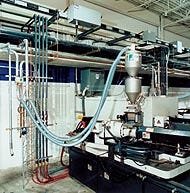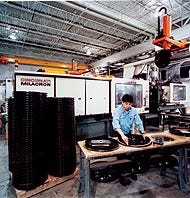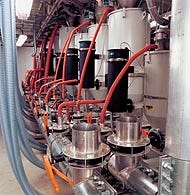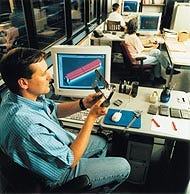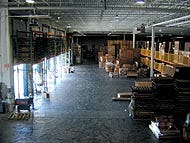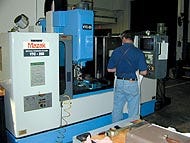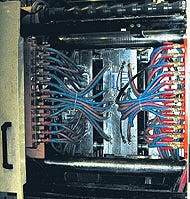Duerr's 33 machines include five electrics, and the expansion space will almost certainly be filled by more electrics along with value-adding secondary operations.
August 13, 2000
|
Duerr's 33 machines include five electrics, and the expansion space will almost certainly be filled by more electrics along with value-adding secondary operations. |
Thanks to steady growth, New Jersey-based molder/moldmaker Duerr Inc. just completed a move—its third in 34 years of business—into a larger facility. More important, the company was able to make good use of its molding and moldmaking experience by designing a purpose-built plant from scratch on a greenfield site. And not just any green field. The land under the new Duerr facility quite literally contains the personal roots of the founders and their sons who are now active in the business.
The choice of location underscores a business philosophy that stresses excellence in the fundamentals of molding and moldmaking, while also advancing into new markets with new technologies. Duerr proves that a business can be family owned and progressive. Today’s concerns include maximizing the value of the shipped product, shortening client time-to-market cycles, and adding profitable client services. As one manager says, taking time and cost out of molded parts and product assemblies is the core of Duerr’s business.
Moldmakers Become Molders
When brothers Karl and Walter Duerr arrived in the U.S. from Germany, they were well trained, experienced toolmakers. They went to work for a small toolmaker in the town next to the current location, and in 1966 took the opportunity to buy it from the previous owners. Duerr Tool & Die was off and running, and less than three years later, responding to customer needs, the company bought its first injection molding machine. It now has 33 presses.
Today, though molding accounts for about 90 percent of revenue, moldmaking is not neglected. The moldmaking department occupies 16,000 of the new building’s 125,000 sq ft and houses equipment that is updated as frequently, or perhaps more frequently, than the presses. Moldmaking is a priority, particularly now that clients seek faster times-to-market, and Duerr knows its quick turnaround gives it a powerful advantage, particularly in the markets it serves.
|
Duerr makes a variety of products, including those pictured here. |
Duerr was arguably the first producer of generic typewriter and printer cartridges in the U.S., beginning in the early 1970s. This proprietary business is now a subsidiary of Duerr Inc., and as Jens Duerr, vp and gm of molding operations, says, the market may have changed a lot, but it’s still a market with high demand that Duerr is following into its newer technologies. About 20 percent of Duerr’s production is for its proprietary lines; the rest is custom for clients like Schick Razor, Schering-Plough, Revlon, Hitachi, Kodak, Newell/Rubbermaid, and others.
Electrics and Robotics
Duerr Inc. has 33 molding machines ranging from 55 to 850 tons. Most are between 300 and 500 tons and seven are 110 tons or less. They are all supplied by Milacron through The Machinery Group (TMG). Jens Duerr says the long-term relationship, which is something his company likes on the supplier and client sides, is due to excellent support by both the manufacturer and TMG. TMG was involved, for example, in the planning and design of the new facility.
Recently, Duerr began buying fully electric machines and now has five. The company has found that the precision these machines bring to the molding process improves overall efficiency in the molding room, helps quality control, lets Duerr take on more complex molding processes, and reduces the overall noise level. The power savings are measurable, and the cleanliness and minimized maintenance is much appreciated.
Each new machine that comes through the door is also purchased with a robot. For Duerr, robotics are not so much a way to reduce manual intervention as they are to guarantee production consistency. Since client quality demands continually rise, along with product and process complexity, robots are an easily monitored part of the process.
Similar thinking motivated the move to a centralized material handling system. It means that one person can supply any material to any machine as needed, but more importantly the resin is accurately dried and measured, and there is a computerized record of all actions. The Echo System, supplied by Una-Dyn, is easily programmed, including a variable for the amount of reclaim generated at the machine. It includes line structure redundancy to avoid single-point system failure and incorporates 14 dryers.
With technology in general, says Jens Duerr, the company’s position is to be proactive. Duerr has worked with gas assist and overmolding, as well as multicomponent molding, but prefers to keep its machines flexible. In many cases, the company believes, a multicomponent part can be produced as cost effectively in two molds on separate machines as in a dedicated multicomponent machine.
|
|
Air, water, and power were under the floor in the former plant. Now, overhead lines and multiple dryers allow fast reconfiguration. | Improvements in quality and productivity with robots has led to more automation. Here an Ichikoh robot removes drum covers from a 650-ton Milacron electric. |
|
|
Duerr says its new central materials handling system has boosted machine productivity by eliminating material-ready problems. | Duerr's 3-D and 2-D CAD technology is primarily for rapid mold production, but often it's pressed into service for client product design. |
| Increased warehouse space lets Duerr offer more storage and shipping services to clients. |
Design Strengths
Probably as an outgrowth of the design capability it has had in moldmaking, Duerr has worked with clients on product design service since its founding. This has become an increasingly important part of the business—essential, in fact, according to Jens Duerr. The company’s first CAD installation was in 1992, and today it has 3-D and 2-D capabilities using Pro/Engineer, Cadkey, and Mastercam. The company’s first venture into computers was nothing more than a salesman managing mailing lists; now it’s operating through the Internet using FTP sites to upload files in all of the leading interchange formats.
For the most part, customers bring complete CAD files and models, but it’s not unusual to work from a rough sketch or just an idea. Likewise, Jens Duerr says the company has developed a high-level skill in reverse engineering, during which part counts can be reduced and manufacturing processes optimized. The main thing is shortening the cycle. Design has been a bottleneck in the past. Duerr has countered that with overlapping of process segments—concurrent engineering—similar to what it is doing in the toolmaking area.
|
|
To maintain its time-to-quality reputation on the moldmaking side, Duerr continues to invest in leading-edge toolmaking machines like this Roku-Roku graphite cutter. | Putting CNC files on computers at the machine means EDM, machining, and cutting can be performed concurrently, reducing lead times. |
|
|
High-speed cutting, as performed by this Mazak station, helps maintain Duerr's fast turnaround time on molds, as does moving CNC programming onto the toolroom floor. | Automation and a stack mold make Duerr competitive with video cassette boxes. |
A Leading Edge
Oliver Duerr, vp and gm of engineering and moldmaking operations, notes that, along with purchasing new moldmaking equipment and expansion of the work space, the company is moving more CAD/CAM work onto the toolroom floor. It hasn’t reached the no-drawings stage, and it’s not sure it ever will, but the company’s getting closer all the time. Project RID (Reduce Industrial Drawings) is working, the company says, but it is a gradual process. The advantages of being on-screen are obvious and powerful, but when a group of people needs to work together, a print is often the only option. Certain clients also want a paper trail of the development, so any decision to go completely paperless will not happen until clients follow suit.
The time saved by the toolmakers doing their own programming, often while metal is being cut, is a big part of the time compression effort. There is little back and forth movement between the shop floor and the designers. Keeping the CNC files in the shop also permits work overlap. Electrodes can be finished while cores and cavities are worked.
Whether or not it results from the company being founded by toolmakers, Duerr stays very up to date in moldmaking technology. There are conventional RAM EDM machines, CNC-controlled milling machines, a three-axis high-speed vertical machining center, and a 3-D-capable Roku-Roku electrode machining center with a 12-tool changer.
Not only are these big time savers, but they also support very complex shapes. Duerr also has two current generation Mitsubishi CNC EDM centers with 16-position tool changers and fuzzy logic controllers. The fuzzy logic, says Oliver Duerr, has lived up to its promise. Its ability to anticipate and adjust to potential problems in machining paths and sequences allows long periods of unattended operation.
New Plant Points the Way
The managers of Duerr are excited about the new plant. It rests on land that Jens and Oliver Duerr used as a soccer field when growing up. It was part of a German cultural center that had fallen into disuse in recent years and became the prime location for a new 125,000-sq-ft molding facility.
Not only does this new plant have more space, but that space is much better used. First, it’s contiguous as opposed to being spread over several buildings, which was the case previously. It has an overhead crane system designed specifically for injection molding. Likewise the electric, air, and water systems in the production area are overhead and use a modular design. Duerr can quickly add machines or move the current units anywhere in the plant. All systems are oversized to avoid capacity problems, and redundancy ensures that work on one machine never impacts another.
The move from the old plant to the new one was carefully planned. For example, Duerr shut down two 400-ton machines in the morning in the old plant and had them running that evening in the new facility. That capability helps the company maintain an uptime rate that is generally better than 85 percent, and often above 90 percent. Mold change times are 40 percent faster now that molds are located adjacent to the presses. The crane system and the open layout also speed things up. Duerr has more than 250 active molds and will do three to seven changes during an average shift. In this plant, all molds are prestaged and await changeover.
Apart from all the other benefits of the new facility, there is additional space around the machines that can be used for operations that meet the company’s goal of adding value to the product. Decorating, welding, inserting, and even assembly can be done beside the press, as well as in the new plant’s dedicated assembly area.
VITAL STATS |
DUERR INC., UNION, NJ |
Square footage: |
Annual sales: |
Markets served: |
Major customers: |
Materials processed: |
Raw material used: |
No. of employees: |
Shifts worked: |
Molding machines: |
Secondary operations: |
Internal moldmaking: |
Quality: |
Contact information |
About the Author(s)
You May Also Like

